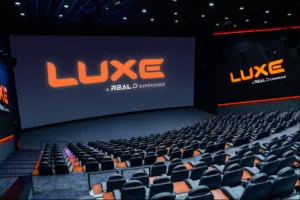RealD has developed its own PLF cinema concept it has been branding a “Luxe” theater. At CinemaCon, we met with the company and discovered they are changing this name to “RealD Cinema.”
Like others with branded theatrical environments, RealD plans to carefully design and control the entire environment in these theaters. For the projectors, they will use only high contrast models with RGB laser projection. Apparently, they are designing lenses with reduced flare and smaller apertures to enable higher contrast that might be considered an HDR theater (no definition exists yet). There will be careful attention to the auditorium design to minimize reflections and ambient light that might compromise the contrast. This includes selection of light absorbing black materials and special baffles for the exit lights. RealD and Barco have shown that even small amount of reflected or ambient light can quickly degrade the on-screen contrast.
The screen will be their Ultimate screen that is specially designed to have high stereo contrast, is polarization preserving and features a micro-perf technology for speaker placement behind the screen. This 2.2 gain will be curved as well and is designed to create 14 FL in 2D or 3D. The idea is to create a PLD theater experience with the performance of a Dolby Cinema or IMAX theater, but at lower cost.
RealD told us that the roll out of the Ultimate screen is happening, but slowly. There are now a dozen installations including a 70” screen in the new LA Live auditorium.
We also got a chance to see another demo of the company’s TrueMotion technology. We described this synthetic shutter technology in RealD Develops Synthetic Shutter Solution for HFR and profiled its use in Creating Derivatives from the 4K/120/3D “Billy Lynn” Master.
RealD’s Tony Davis described a special movie they made to illustrate how the synthetic shutter can be allied in different ways to the movie in a post production process. All content was captured at 120 fps on a 3D stereo Arri Alexa rig with a 360º shutter. Different scenes can then be treated different with various custom shutters to create a standard 24 fps film look, or to create other looks where there is less motion blur – but without having a “video” look. The technique can even be done in windows so that a face can have one shutter to make it clear while the body has more motion blur. This is a very cool tool. – CC

